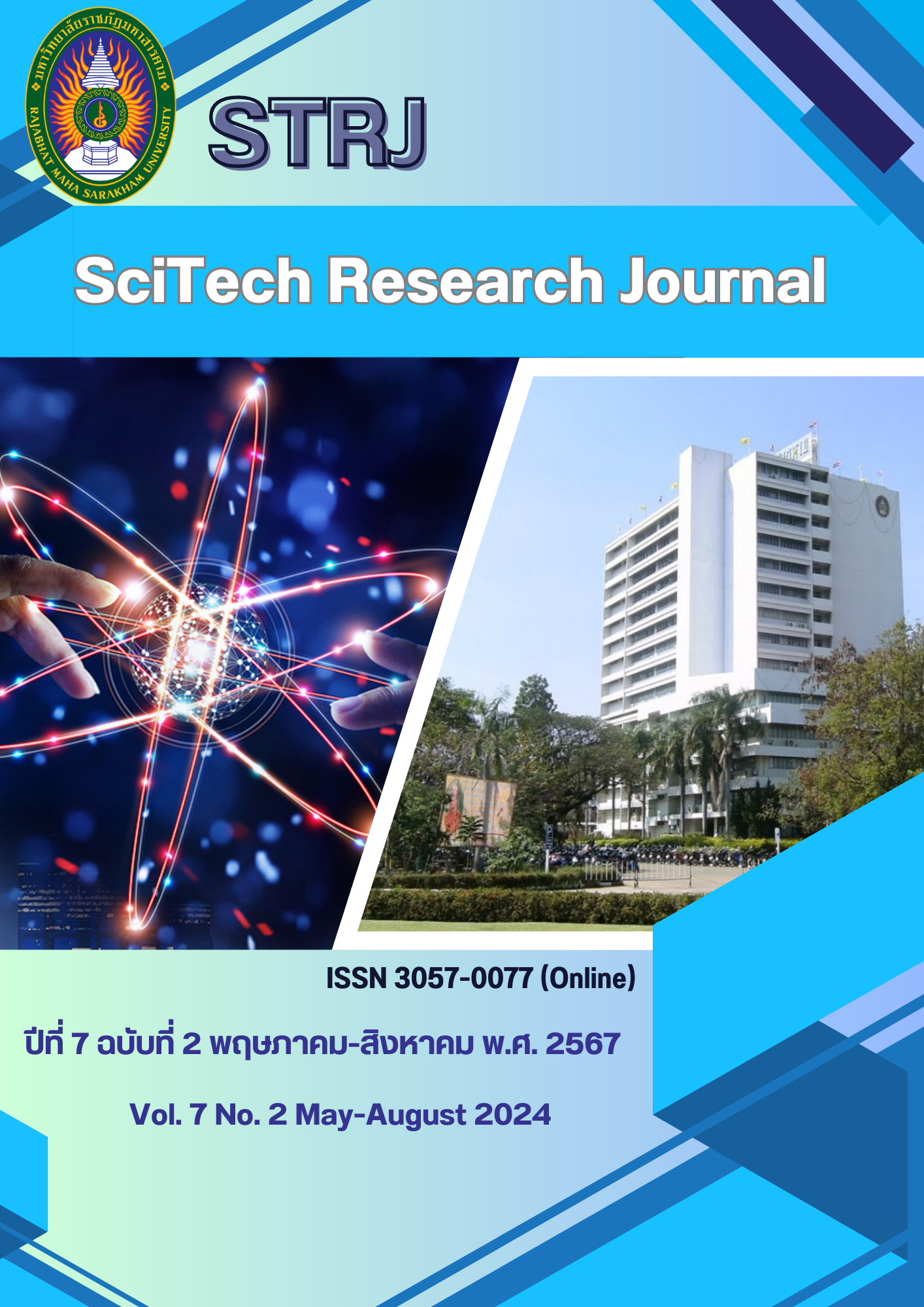The Study of Total Phenolic Compounds and Antioxidant Activity of Asparagus racemosus willd. Extracts
Keywords:
Total Phenolic Compounds, Antioxidant, Asparagus racemosus willdAbstract
This research investigates the total phenolic content and antioxidant activity of the herbal plant Asparagus racemosus willd (Raksamsib) extracts which using different solvents from Sakon Nakhon, Chaiyaphum, and Phetchabun provinces. The total phenolic content was tested by the Folin-Ciocalteu method, and the antioxidant activity was tested by the DPPH radical scavenging assay. The results showed that the total phenolic content from Phetchabun extracted with methanol was the highest, which measured 180.63±2.39 mg GAE/g, followed by the methanol extract from Sakon Nakhon, which measured 163.38±2.48 mg GAE/g. The lowest phenolic content was found in the 95% ethanol extract from Sakon Nakhon, which measured 62.47±2.00 mg GAE/g. As for the antioxidant activity test, the 95% ethanol extract from Sakon Nakhon exhibited the best antioxidant activity with IC50 of DPPH at 0.16 µg/g extract, followed by the methanol extract from Sakon Nakhon with an IC50 of DPPH at 0.19 µg/g extract.
References
Ahmad, M. P., Hussain, A., Siddiqui, H. H., Wahab, S., & Adak, M. (2015). Effect of methanolic antioxidants: An electrochemical overview. BioMed Research International, 2015, Article ID 921305.
Athawongsa, K. (2015). Herbal for Menopause. Bangkok: Herbal Information office, Faculty of Pharmacy Mahidol University.
Bhandary, B. S. K., Sharmila, K., Kumari, N. S., Bhat, V. S., & Fernandes, R. (2017). Acuteand subacute toxicity profile of Asparagus racemosus root extract, Isoprinosine and shatvari syrup in Swiss albino mice. Journal of Applied Pharmaceutical Science, 7(05), 129-135.
Brand-Williams, W., Cuvelier, M. E., & Berset, C. (1995). Use of a free radical method to evaluate antioxidant activity. LWT - Food Science and Technology, 28(1), 25-30.
Butkup, L. (2012). Comparative study of flavonoid content. and anti-oxidation effects in various mulberry species: complete research report. Office of the Science Promotion Board. Research and innovation.
Chankhonkaen, P., Watthanawikayakit, P., & Boonmeviset, S. (2019). Anatomy of Asparagus racemosus. Ramkhamhaeng Research Journal (Science and Technology), 22(1), 1-10.
Inrod, P. (2008). Antioxidant Activity and Total Phenolic Content of Extracts from Kaempferia Galanga and Curcuma Aeruginosa (Master’s Thesis). Chonburi: Burapha University.
Jiang, J., Wu, S., & Zhu, W. (2021). Optimization of ultrasound-assisted extraction of phenolic compounds from Morus alba L. leaves. Journal of Food Science and Technology, 58(4), 1471-1480.
Li, H., Wang, Z., & Liu, Y. (2017). Phenolic profiles and antioxidant activity of Lonicera species. Food Chemistry, 212, 343-351.
Prathanturaruk, S. (2000). Encyclopedia of Herbs, Volume 1. Bangkok: Sirirukachart Herb Garden, Department of Pharmacognosy, Faculty of Pharmacy, Mahidol University.
Prathet, K. (2000). A Survey of Plant Species in Kamphaeng Phet Historical Park, Mueang District, Kamphaeng Phet Province. Maha Sarakham: Mahasarakham University.
Renukadevi, K., & Suhani, J. (2011). Phytochemical analysis and total phenolic content in Indigoferatinctoria. Journal of Medical Plants Research, 5(15), 3487-3491.
Robbins, R. J. (2003). Phenolic acids in foods: An overview of analytical methodology. Journal of Agricultural and Food Chemistry, 51, 2866-2887.
Shameem, I., & Majeedi, S. F. (2020). A review on potential properties and therapeutic application of asparagus racemosus wild. World Journal of Pharmaceutical Research, 9(7), 2532-2540.
Siriamornpun, S. (2014). Antioxidants in food. Bangkok: Odean Store.
Sutthajit, M., Bunjerdpongchai, R., Khukongwiriyapan, W., Siriamornpun S., Chaisut, C., Parasupattana, S., Panich U., Thephinlup, C. & Chareansin S. (2012). Free radicals and Antioxidant. Chiang Mai: Smart Coating and Service.
Teixeira, J., Gaspar, A., Garrido, M., Garrido, J., & Borges, F. (2013). Hydroxycinnamic acid of extract of Asparagus racemosus Willd. on lipopolysaccharide-induced-oxidative stress in rats. Pakistan Journal of Pharmaceutical Sciences, 28(2), 509-513.
Traisomboon, J. (2010). Effects of Asparagus racemosus Willd on Estrogen Hormone Activity. Bangkok: Office of Science Promotion, Research, and Innovation.
Wang, L., Yang, R., Yuan, B., Liu, Y., & Liu, C. (2012). The antiviral and antioxidant activities licorice, a widely-used Chinese herb. Journal of Ethnopharmacology, 146(3), 668-675.
Zhao, L., Chen, X., & Tang, C. (2018). Comparison of different solvent extraction methods for total phenolics and total flavonoids from guava leaves and antioxidant activity. Journal of Food Science and Technology, 55(9), 3640-3648.


